WiFi Planning Tool runs on a MacBook (macOS 11+) or any laptop (Windows 7/8/10/11) with a standard 802.11a/b/g/n/ac/ax/be wireless network adapter.
Best Wi-Fi Planning Tools
Looking for the right Wi-Fi planning software? Explore the top tools with predictive survey capabilities to optimize coverage, reduce interference, and avoid dead zones.
Planning a wireless network before deployment is essential if you want stable performance and full coverage without unexpected dead zones. Wi-Fi network design has become a technical field in its own right, requiring a solid understanding of signal behavior, interference, and hardware capabilities.
That’s why WiFi planning tools have become an important part of both professional and DIY network projects. Whether you're building a new network from scratch or improving an existing one, using the right WiFi planning software helps you avoid costly mistakes and ensures your network performs as expected.
What a Wi-Fi planning tool does for you
Before we get into the tools themselves, let’s take a minute to understand why WiFi planning software is so important — and what it actually helps you solve. Whether you’re rolling out a massive enterprise network or just want rock-solid coverage in your new office, a good WiFi planner takes the guesswork out of the process.
A proper WiFi planning tool helps answer three critical questions:
- Will there be a strong signal and reliable coverage in every part of the building?
- Can the network capacity handle the number of users and connected devices, especially during peak hours?
- Are nearby access points, physical obstacles, or electronic devices likely to cause signal issues and Wi-Fi interference?
By addressing these factors in advance, planning tools let you make informed decisions about how many access points you need, where to place them, what channels to use, and what equipment configuration will deliver the best performance. This saves time, reduces guesswork, and helps ensure long-term reliability.
There’s a wide range of WiFi planning software available today, each offering different features and levels of complexity. In the next section, we’ll take a closer look at four of the most popular tools on the market — and explain why NetSpot stands out as our top pick.
| NetSpot | |
| Functionality | 🟢 Wide |
| Ease of Use | 🟢 Extremely intuitive (great for beginners & pros) |
| Multiplatform Support | 🟢 Windows, macOS, Android |
| Wi-Fi 6/7 Support | 🟢 Yes (Wi-Fi 6 & 7) |
| Subscription Required | 🔴 No |
| Ekahau AI Pro | |
| Functionality | 🟢 Wide |
| Ease of Use | 🔴 Complex, certification recommended |
| Multiplatform Support | 🟢 Windows, macOS |
| Wi-Fi 6/7 Support | 🟢 Yes (Wi-Fi 6 & 7) |
| Subscription Required | 🟢 Yes |
| Acrylic WiFi Heatmaps | |
| Functionality | 🟡 Medium |
| Ease of Use | 🟢 Moderate learning curve |
| Multiplatform Support | 🔴 Windows only |
| Wi-Fi 6/7 Support | 🟢 Yes (Wi-Fi 7) |
| Subscription Required | 🟡 Partially (advanced features) |
| Cambium Wi-Fi Designer | |
| Functionality | 🔴 Limited |
| Ease of Use | 🟢 Web-based, beginner-friendly |
| Multiplatform Support | 🟢 All OS via browser |
| Wi-Fi 6/7 Support | 🔴 No explicit Wi-Fi 6/7 support |
| Subscription Required | 🔴 No (Free) |
NetSpot’s Planning Mode acts as a virtual design tool, simulating Wi-Fi coverage and performance before installation to help you place access points with precision.
-

Inspector Mode
Gives you real-time insights into the WiFi networks around you..
-

Survey Mode
Provides a comprehensive, map-based analysis of your WiFi network's performance.
-

Planning Mode
Enables you to simulate and plan your WiFi network's layout and coverage.

NetSpot delivers a professional-grade WiFi planning tool with a user-friendly design that works for beginners and advanced users alike.
NetSpot includes a convenient floor-plan editor that lets you draw walls, doors, and windows and assign real building materials with specific thickness and signal-loss values. If a material isn’t listed, you can manually enter custom parameters to better match your space and simulate how Wi-Fi signals will behave in real conditions.
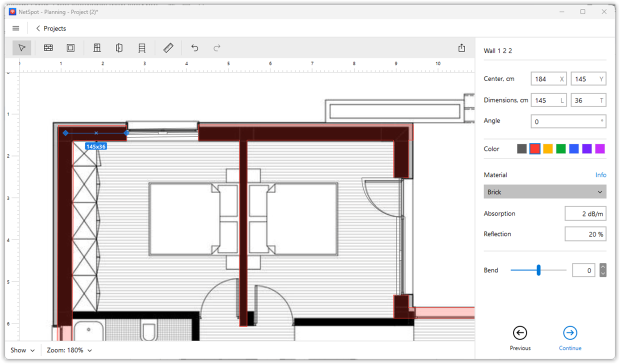
The tool comes with a large library of access points from all major vendors. If your exact model isn’t there, you can define a custom AP by entering transmit power, frequency support, and other specs.

You can also experiment with different antennas — select between omnidirectional or directional models, adjust gain, and even change the tilt angle to simulate real-world installation scenarios.

In Planning Mode, NetSpot provides nine focused heatmaps to simulate WiFi behavior before deployment:
- Signal Level
- Signal-to-Interference Ratio
- Secondary Signal Level
- Quantity of Access Points
- Frequency Band Coverage (2.4 GHz, 5 GHz, 6 GHz)
- PHY Mode Coverage (802.11 a/b/g/n/ac/ax/be)
- Low Signal Level Areas
- Overlapping Channels (SIR)
- Low Secondary Signal Level
These heatmaps allow you to quickly evaluate coverage quality, network density, and interference risks — ensuring your design performs before any hardware is installed.
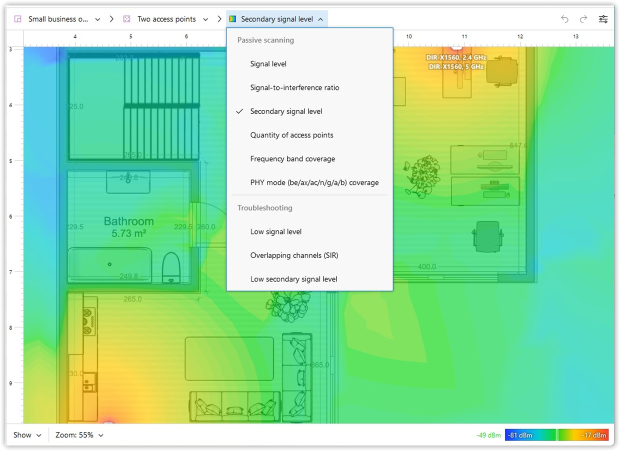
What makes it even more convenient is that Planning Mode is also available in the Android version of NetSpot — so you can build and adjust your wireless design directly on your phone or tablet, without needing a laptop.
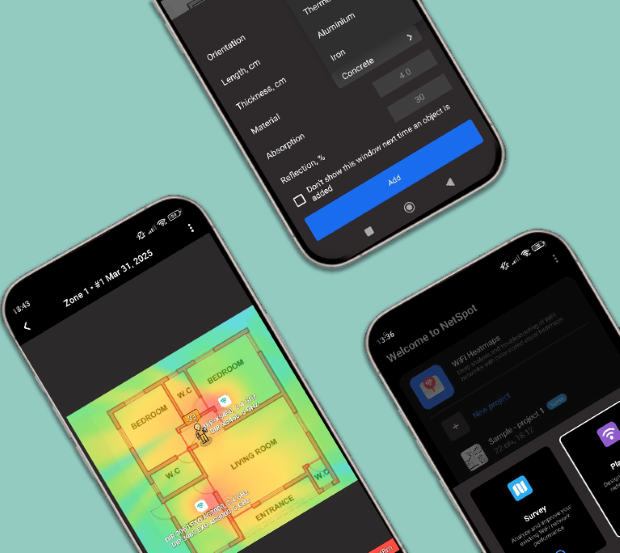
Beyond planning, NetSpot includes Inspector Mode for real-time network scanning and Survey Mode for on-site measurements. Together, these modes give you full control over WiFi design, validation, and ongoing optimization — from simulation to real-world tuning.
Ideal for:
Home users, IT admins, and wireless professionals who want a balance of advanced planning features and ease of use — without needing additional hardware or certification. Perfect for designing, validating, and troubleshooting Wi-Fi networks across platforms.
-
Support for Wi-Fi 6 and Wi-Fi 7
-
Intuitive and easy to use
-
Works on Windows, macOS, and Android
-
No subscription required
-
Includes Planning, Survey, and Inspector modes
-
Custom walls, APs, and antenna settings
-
Accurate simulations
-
Advanced visualizations
-
No automatic AP placement
- Summary recommendation: Get NetSpot
Ekahau AI Pro is an advanced Wi-Fi planning and optimization platform built for large-scale enterprise networks. It’s widely recognized as an industry standard among wireless engineers and is typically used in complex environments like hospitals, warehouses, manufacturing sites, and corporate campuses.
It offers a powerful set of tools:
- AI Auto-Planner that automatically places access points based on wall materials, floor height, and coverage requirements
- Automatic Channel Planner for all three bands (2.4, 5, and 6 GHz)
- Network Simulator to test AP models and “rip-and-replace” scenarios before purchasing any gear
- Advanced reflections and diffractions modeling for ultra-precise signal predictions
- Automatic wall calibration using data from the Ekahau Sidekick 2
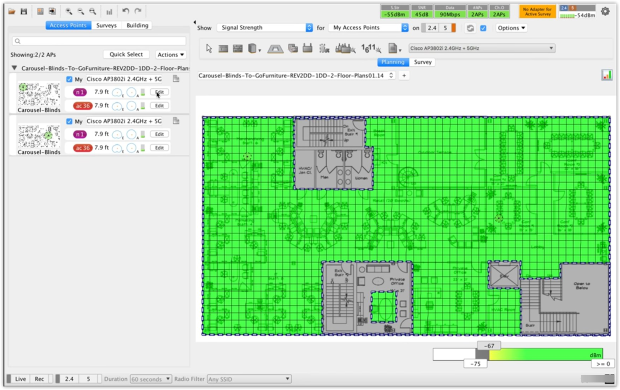
All of this makes Ekahau a powerful, but far from simple solution. The interface is divided into four professional modes — Design, Survey, Inspect, and Live — and the software itself requires not only a deep understanding of Wi-Fi fundamentals, but also proper training. It’s no surprise the company offers a dedicated certification course (ECSE), without which even seasoned professionals may struggle to unlock the tool’s full potential.
Ekahau AI Pro is definitely built for professionals who need precision, scalability, and full control over every detail. But for most users, it might be overkill — both in terms of complexity and cost.
Ideal for:
Enterprise-level network engineers, consultants, and system integrators working on large-scale or high-density deployments. Best suited for teams that need precision, capacity modeling, and full integration with specialized hardware like Ekahau Sidekick.
-
AI-driven design
-
Wi-Fi 7 support
-
Advanced visualizations
-
High price
-
Requires additional hardware (Sidekick 2)
-
Not beginner-friendly, has a steep learning curve
Acrylic WiFi Heatmaps is a user-friendly WiFi planning software that offers a solid set of features for straightforward wireless network design. Built specifically for Windows, it’s ideal for creating reliable Wi-Fi coverage maps without diving too deep into complex RF modeling.
Users can import floorplans, define wall materials, and place virtual access points to instantly visualize how signals will propagate through the environment.
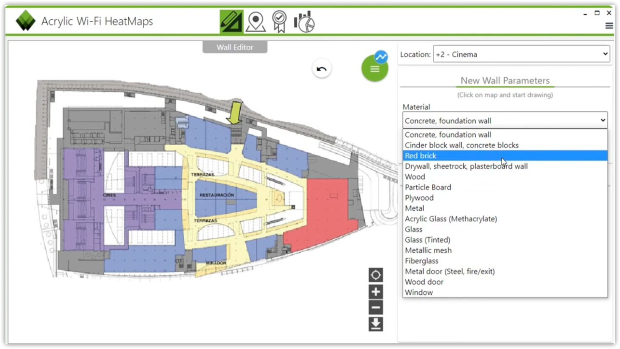
It also supports adjustments for power levels, antenna types, and installation heights, allowing for quick design iterations.
The tool offers a wide range of heatmaps — signal strength, interference, and more.

While Acrylic makes Wi-Fi planning accessible, its feature set is more limited compared to high-end tools. Some advanced features, like professional report export and continued updates, are only available with a subscription.
While it offers powerful analysis tools, users have reported that initial setup — especially for GPS tracking and adapter compatibility — can be time-consuming and not always intuitive. The trial version is also fairly limited, so to take full advantage of its capabilities, a paid license is required.
Ideal for:
It’s best suited for smaller-scale deployments where simplicity and speed matter more than deep technical analysis.
-
Simple interface
-
Supports Wi-Fi 7
-
Affordable and easy to get started
-
Windows-only
-
Complicated setup for some features
-
Lacks advanced modeling features (capacity, throughput)
-
Some features require a paid subscription
Cambium Wi-Fi Designer is a free, cloud-based WiFi planning tool designed specifically for networks built with Cambium access points. It allows users to upload or draw floorplans, define wall materials, and simulate coverage using Cambium’s e-series AP catalog.
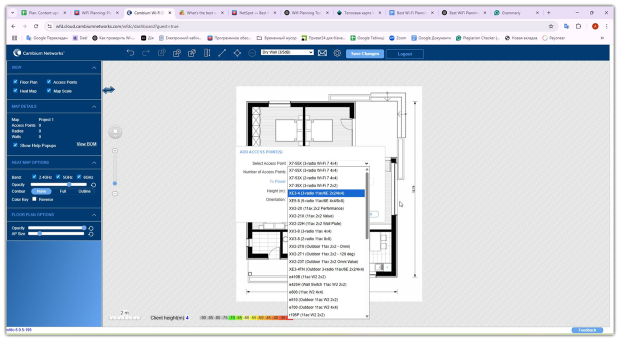
The tool automatically generates heatmaps and a bill of materials, helping integrators plan hardware placement and estimate project costs quickly and efficiently.

Because it runs entirely in the browser, there’s no need to install anything — making it convenient for quick planning on any device or OS. The interface is streamlined and simple to use, making it accessible even for those with limited planning experience.
That said, Cambium Wi-Fi Designer has clear boundaries. It supports only Cambium-branded hardware, which makes it unsuitable for projects involving mixed-vendor environments. The tool also lacks more advanced planning features like capacity modeling, interference analysis, or predictive validation under different user loads. It’s ideal for straightforward coverage projects, but not for complex or high-density deployments.
Ideal for:
Installers and integrators deploying Cambium-only networks who need a quick, browser-based tool for basic coverage planning and generating equipment lists. Best for small projects or pre-sales planning where simplicity is key.
-
Completely free to use
-
No installation required — works in any modern browser
-
Generates heatmaps and equipment lists for Cambium networksvv
-
Only supports Cambium hardware
-
No capacity or interference modeling
-
Lacks spectrum analysis or survey features
-
Limited flexibility for large or complex projects
Final Verdict
Each of these WiFi planning tools brings something useful to the table — whether it’s advanced simulation, channel optimization, or rich heatmap visualizations. But when it comes to combining accuracy, ease of use, and cross-platform flexibility, NetSpot stands out.
It delivers professional-grade WiFi planning software with a clean, user-friendly interface that doesn’t require a steep learning curve or expensive hardware. Whether you’re setting up a home network, managing a small business, or planning coverage for a large building, NetSpot helps you get it right the first time — with fewer surprises during deployment.
If you're looking for the best balance of power, simplicity, and value in a WiFi planning tool, NetSpot is the one to trust.
FAQs: Best WiFi Planning Software
For home users looking for a balance of accuracy and simplicity, NetSpot is often considered the best option. It offers predictive surveys, heatmaps, and intuitive controls — no special hardware or certifications needed.
Wi-Fi simulation lets you test coverage, signal strength, and interference before installing any hardware. This helps avoid dead zones, poor performance, and overbuying access points — saving time and money during deployment.
If you're planning a new network or upgrading an existing one, predictive surveys are highly recommended. They allow you to simulate WiFi behavior based on floor plans, wall materials, and AP specs — giving you a clear view of coverage and potential interference before rollout.
NetSpot is widely praised for its clean interface and step-by-step process. It's ideal for beginners but still powerful enough for IT admins and wireless professionals.
Yes, NetSpot supports both Wi-Fi 6E and Wi-Fi 7, including simulation of the 6 GHz band. This makes it a future-proof solution for next-generation wireless planning.
Yes, NetSpot offers a dedicated Android app with full Planning Mode support. It lets you simulate coverage, draw floor plans, and model access point placement directly from your phone or tablet.
